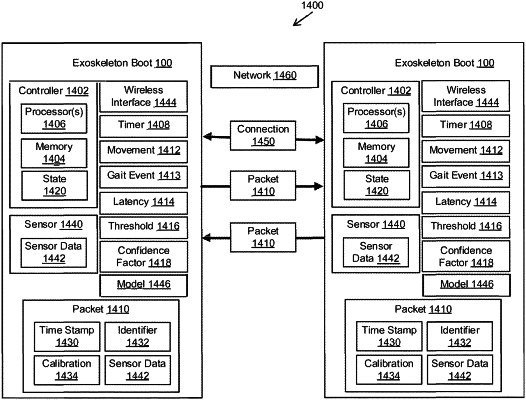| CPC A61H 3/00 (2013.01) [G16H 20/30 (2018.01); G16H 40/67 (2018.01); A61H 2003/007 (2013.01); A61H 2201/1207 (2013.01); A61H 2201/1642 (2013.01); A61H 2201/165 (2013.01); A61H 2201/5097 (2013.01)] | 20 Claims |

|
1. A system, comprising:
a first exoskeleton, for at least one of a first foot or a first ankle of a user, comprising:
an actuator to provide torque about an axis of rotation;
a sensor; and
a controller comprising one or more processors, coupled to memory, to:
communicate, via a wireless connection, one or more packets with a second exoskeleton for the user;
identify a latency of the wireless connection between the first exoskeleton and the second exoskeleton based on a time difference associated with the one or more packets transmitted between the first exoskeleton and the second exoskeleton during the communication; and
generate, based on the latency of the wireless connection, a command for the actuator to provide the torque.
|
|
16. A method, comprising:
providing a first exoskeleton for at least one of a first foot or a first ankle of a user, the first exoskeleton comprising:
an actuator to provide torque about an axis of rotation;
a sensor; and
one or more processors coupled to memory;
communicating, by the one or more processors via a wireless connection, one or more packets with a second exoskeleton for the user;
identifying, by the one or more processors, a latency of the wireless connection between the first exoskeleton and the second exoskeleton based on a time difference associated with the one or more packets transmitted between the first exoskeleton and the second exoskeleton during the communication; and
generating, by the one or more processors based on the latency of the wireless connection, a command for the actuator to provide the torque.
|